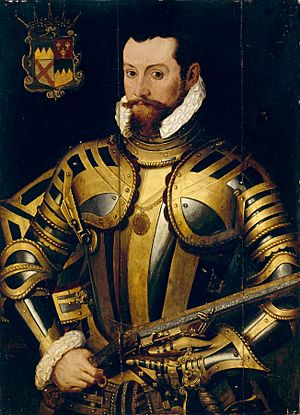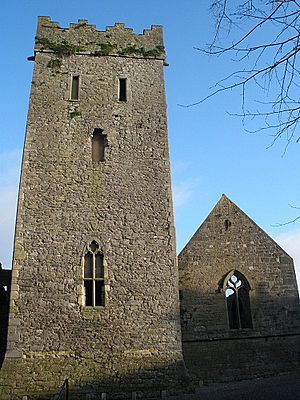Gerald Comerford facts for kids
Gerald Comerford (born around 1558 – died 1604) was an important Irish lawyer, judge, and government official in the late 1500s and early 1600s. He was a member of the Irish Parliament from 1585 to 1586. He also served briefly as the main judge for the area of Munster and as a Baron (a type of judge) in the Irish Court of Exchequer.
Gerald Comerford became successful quickly because of his close connection to the Earl of Ormond. The Earl was a favorite of Queen Elizabeth I, who was his cousin. Gerald Comerford became a trusted helper for the English Crown (the Queen's government). He likely would have become one of the most powerful people in southeast Ireland if he hadn't died so young.
Contents
Early Life and Family
Gerald Comerford was born in Callan, County Kilkenny. He was the second son of Fouke Comerford and Rosina Rothe. His father worked for the Earl of Ormond as both his lawyer and someone who managed his land.
The Comerford family originally came from Waterford. An earlier family member, Fouke Comerford, was the Mayor of Waterford in 1433 and again in 1448. From the 1530s, the family became big landowners in County Kilkenny. They bought land from older families. However, their property was badly damaged during the Desmond Rebellions (a series of wars) from 1569 to 1573.
Gerald's sister, Catherine, married Sir John Everard. This connected the Comerfords to one of the main landowning families in County Tipperary. In 1569, it was reported that "old Fulco Comerford" lost a lot of valuable things, including money, silver, household goods, and farm animals.
Starting His Career
Gerald went to school at Kilkenny College. Like many younger sons from landowning families back then, he chose to become a lawyer. He joined the Middle Temple (a place where lawyers are trained in London) in 1578.
During the end of the Second Desmond Rebellion (1579-1583), the Queen's government asked him to talk with the rebels. But when he tried to arrange a meeting, he was attacked by the rebels and badly hurt.
After returning to England, he asked Queen Elizabeth I for help because of his injuries while serving her. He was given a yearly payment and permission to go back to Ireland to get better. He also received land in Kilkenny. He joined the King's Inns (another legal training place in Dublin) and quickly became a successful lawyer in Ireland. This was thanks to the support of Thomas Butler, 10th Earl of Ormonde, who he was always close to. In 1584, he was made the Attorney General (a chief lawyer for the government) for the area of Connacht.
His Role in Politics
Gerald Comerford's political career moved forward quickly. In the Parliament of Ireland (the Irish government's law-making body) of 1585–1586, he was chosen as one of the two representatives for the new town of Callan. He used his growing power to get back lands that had been taken from his relative, Henry Comerford.
His career faced a small problem in 1587 because he was against Sir John Perrot, who was the Lord Deputy of Ireland (the Queen's main representative in Ireland). Comerford was part of a group that worked to remove the Lord Deputy, and he was even put in prison for a short time because of this.
After Perrot was called back to England in 1588, Comerford gained the support of Sir Richard Bingham, the main official in Connaught. Comerford was then appointed a member of Bingham's Council. He seemed to have a general role as the Queen's representative in North County Mayo. He often had disagreements with the powerful Burke family in that area.
In 1588, after the Spanish Armada (a large Spanish fleet) was defeated, Comerford was given the job of watching and reporting on the remaining Spanish ships as they sailed down the west coast of Ireland. He didn't have enough men to fight them, but he was a very dedicated official. Bingham later praised him for his fifteen years of unpaid work as Attorney General for Connacht.
In 1591, he visited the English Court. There, he was praised for his loyalty to the Queen and was made Attorney General of Connacht for life. In the same year, his old enemy Perrot was accused of serious disloyalty and died soon after in the Tower of London.
During the Nine Years War, the Queen's government lost control of Connacht. But Comerford showed his dedication by staying in the main city of the province, Galway. He relied on the protection of loyal Irish nobles, like Ulick Burke, 3rd Earl of Clanricarde. In 1597, he reported on how troubled the province was. He was given armed guards but complained that his salary was not being paid, and he had to pay the guards himself. In 1599, he went to Ennis and reported back to the Queen's government about the difficult conditions there.
Working in Munster
In 1600, perhaps because he often complained about not being rewarded enough for his fifteen years of loyal service, he was appointed to the Council of the main official in Munster. He also became the second judge of that official's court. During the final parts of the Nine Years War, the usual courts stopped working in Munster. The official's court took over all legal cases in the area.
Comerford was present at the Battle of Kinsale. Even though he wasn't known as a soldier, he is said to have fought against Hugh O'Neill, Earl of Tyrone. In 1603, he was part of the court that heard the case of William Meade, who was accused of disloyalty. Even though the judges strongly pushed for a guilty verdict, the jury found Meade not guilty. The jury members were then punished for not following the court's wishes.
Later Life and Death
In 1604, he was made the Chief Justice (the main judge) of Munster. He was also made a Baron of the Irish Court of Exchequer, which was unusual for a Chief Justice. This happened because another judge, Patrick Segrave, was removed from his position. Gerald Comerford appointed someone else to do his work as a Baron. This shows that his health was getting worse quickly.
He died in November 1604, at Coolnamuck in County Waterford. He was still under 50 years old. He had inherited his family's lands from his older brother and added much more to them. His main home was Castleinch in County Kilkenny. This place had belonged to the de Valle family, who sold it to Gerald's father around 1560. The Comerford family lived there until the 1650s. He was buried at St. Mary's Church, Callan, where his impressive tomb can still be seen today.
Family Life
Gerald Comerford married Johanna Walsh. She was the daughter of James Walsh, who was the Mayor of Waterford, and the sister of his fellow judge, Sir Nicholas Walsh. Johanna lived longer than Gerald.
According to his will (his legal document about his property after death), they had six children: Fouke, Nicholas, Edward, James, Patrick, and Mary. Fouke inherited the family lands and died in 1623, leaving children. James became a Jesuit (a Catholic priest), which might have led to rumors that his father was secretly Catholic. Mary lived to be quite old and was still alive in 1644, but she is not known to have married.
His Religion
Gerald Comerford appeared to be a strong Protestant. He was willing to strictly enforce the laws against recusancy (not attending Church of Ireland services), even if it affected his friends and relatives. He issued a public statement against several Catholic priests, including the well-known Jesuit James Archer. Archer was from Kilkenny, so Comerford must have known him personally. Comerford called these priests "disloyal people."
It was expected that anyone holding a government job in Ireland during Queen Elizabeth's time would publicly follow the Church of Ireland. However, as shown by the career of Comerford's relative Sir John Everard (who married Gerald's sister Catherine), those who truly believed in the Roman Catholic faith found it impossible to keep their jobs in the long run if it went against their beliefs.
It's hard to know if there's any truth to the rumors that Comerford (or his brother-in-law Sir Nicholas Walsh) became Catholic just before they died. However, at least one of his sons became a Catholic priest. The rumor about both men seems to have started with David Rothe, who was a Catholic Bishop and a cousin of Comerford. He knew Comerford personally.



